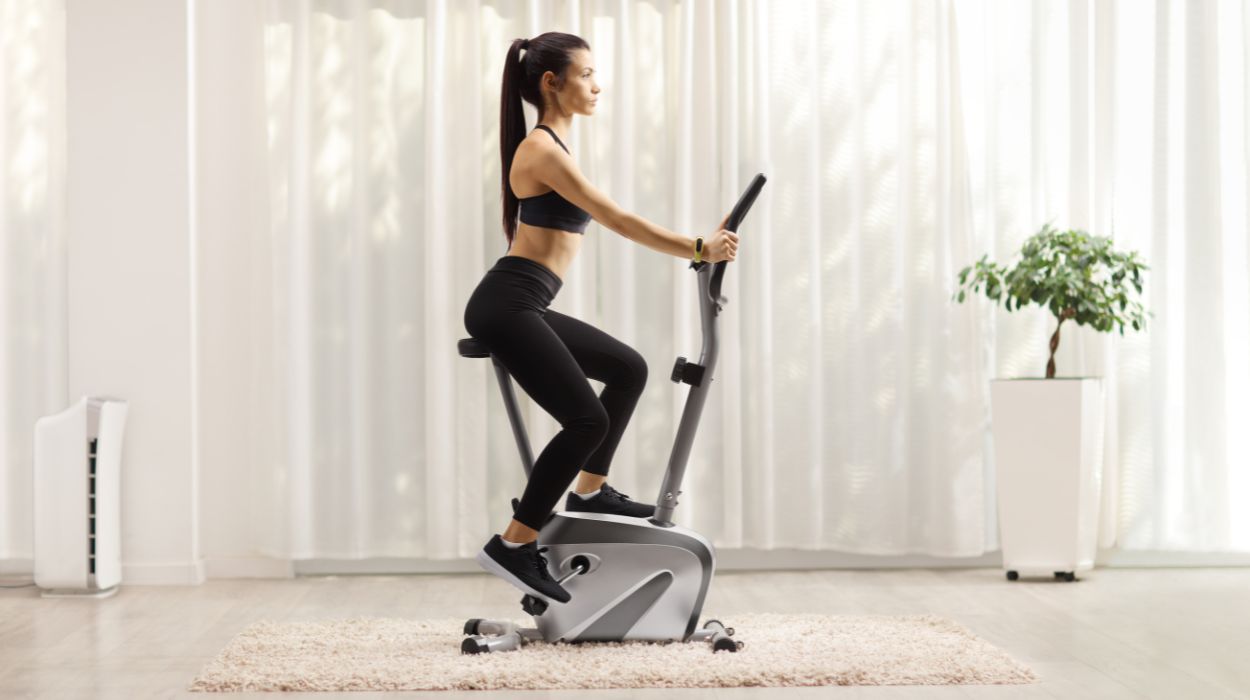You’re looking to drop a few pounds and trying to set some realistic goals. A look at the calories burned during various forms of exercise leaves you stunned and thinking, “I have to do how much cardio to lose weight?”
We get it; the fitness world can sometimes champion ideals that aren’t always attainable. With so much advice floating around, it’s easy to get overwhelmed. But don’t worry, we’ve got you covered!
In this guide, we’ll break down what you need to know about cardio workouts and weight loss. We’ve got all the answers–from calculating how much cardio a day to lose weight to choosing the right type of cardiovascular exercise.
How Much Cardio To Lose Weight?
To lose weight, you must create a calorie deficit by burning more calories than you eat. A deficit of 3,500 calories typically results in a one-pound weight loss. This means that to lose one pound per week, you’d need to burn an extra 500 calories daily through cardio activities like jogging, swimming, dancing, cycling, or jump roping, combined with a balanced diet. For best results, develop a consistent routine and avoid common mistakes such as ignoring diet or pushing too hard too soon.
How Much Cardio To Lose Weight

Losing weight might not be easy, but the theory is straightforward: create a calorie deficit. In simple words, you need to burn more calories than you eat, and cardio is one of the top ways to burn calories. But the million-dollar question is, “How much cardio do I need to lose weight?”
Start by calculating the calories you burn daily and ensuring the number is larger than your calorie intake. For each deficit of 3,500 calories, you can expect to lose one pound. If you’re consuming more calories than you burn, you must adjust by eating fewer calories or adding more workouts to your weekly exercise plan.
The Physical Activity Guidelines for Americans[1] suggest a minimum of 150 minutes of moderate-intensity cardio each week for the average healthy adult. If that sounds like a lot, remember 150 minutes a week is just 20-30 minutes daily.
These guidelines are a great starting point for getting and staying active. However, you can’t outrun a bad diet. While cardio activity can help you burn fat, boost your metabolism, and get closer to your weight loss goals, the calorie deficit necessary to lose belly fat is difficult to achieve through exercise alone.
Best Cardio For Weight Loss
When it comes to shedding pounds, not all cardio exercises are created equal. Here’s a quick rundown of the most popular cardiovascular exercises:
Running
Few forms of exercise are as beloved or resented as running. Running offers varying degrees of intensity, whether it’s a slow jog in the park or an intense sprint. It engages most of your major muscle groups, requires no specialized equipment, and makes tracking your burned calories easy.
Swimming
A full-body workout that’s easy on the joints, swimming is an excellent choice for those looking to lose weight without added stress on the knees or back.
Cycling
Whether indoors on a stationary bike or outdoors in the sunshine, cycling can ramp up your heart rate and increase calorie burn. Indoor spinning classes can be a great way to make new friends and stay accountable. Cycling outdoors is a fun way to explore your surroundings; just remember to wear your helmet!
High-Intensity Interval Training
For those short on time but still looking to use exercise to adjust how long it takes for you to lose weight, HIIT is the answer. HIIT involves engaging in short bursts of intense, repetitive movements followed by a brief rest period. This type of cardio[2] burns calories both during and after your exercise session.
Jumping Rope
A classic that never goes out of style, jumping rope is fun and an excellent way to burn fat. Regarding the number of calories burned, you might be surprised how jumping rope compares to running.
Dance
Turn up the music and shake a leg! Dancing isn’t just a fun social activity and mood booster; it’s also a cardio workout. When calculating how much cardio per week to lose weight, remember that all sorts of enjoyable activities can get your cardiovascular system into the aerobic zone, including games like tag with the children in your life.
How Does Cardio Help You Lose Weight?
Let’s start with the basics. Cardiovascular exercise, usually just called cardio, primarily works your heart and lungs.[3] But it has benefits for all your organ systems.
- Calorie burn: Cardio helps you burn calories, whether on a treadmill, taking a brisk walk, or doing jumping jacks. The more intense the activity, the more calories you torch.
- Boosts metabolism: Cardio can kick your metabolism into high gear, not just during the workout but afterward. These calories burned after exercising result from the afterburn effect.
- Muscle engagement: Although not as effective as strength training exercises, cardio still engages various muscles. Working these large muscle groups increases energy expenditure.
- Improves body composition: While cardio to lose weight is effective, it also helps reduce body fat percentages. This can lead to a healthier body composition, even if the scale doesn’t shift much, by getting rid of fat and replacing it with muscle. A body weight planner can be handy if you want to track more than just weight. And if your goal is toning specific areas, you might be interested in things like how to lose arm fat in two weeks.
- Appetite regulation: Some people find that physical activity helps in appetite regulation.[4] While it doesn’t happen for everyone, the hormonal changes[5] post-exercise can lead to decreased hunger for some.
- Supports mental well-being: This might not directly influence weight, but a sound mind often leads to a sound body. Regular cardio releases endorphins, our natural feel-good hormones, which can reduce stress and elevate mood.
Consider pairing your cardio with strength training to achieve the best results in your weight loss program. Not only will it help you burn fat, but it will also help preserve or even increase muscle mass. This balanced approach not only ensures you lose weight but will also sculpt and tone your body.
Tips On Cardio For Weight Loss

Cardio, when done right, can be a loyal ally in your healthy weight-loss journey. Here are some actionable tips to help you make the most out of your cardio workouts:
Start Slow And Steady
Diving headfirst into any fitness routine can be tempting, especially when you’re eager to see results. However, jumping into intense cardio workouts without a gradual build-up can lead to injuries and quick burnout. It’s crucial to pace yourself, particularly if you’re new to exercise or have been away for a while.
When it comes to how much cardio a day to lose weight, aim for moderate aerobic activity 3-4 times a week, then slowly do more. Remember that consistency is more crucial than intensity. As you gain stamina, you can then increase the duration and intensity. Easing into a weekly exercise routine helps maintain long-term commitment.
Mix It Up
Combining different types of cardio exercises can prevent workout monotony and challenge different muscle groups. For example, alternate between cycling, swimming, and a dance class. Every activity offers unique benefits. Keep it fresh and fun!
Incorporate Interval Training
Unlike steady-state cardio, where the exercise intensity remains consistent, high-intensity interval training oscillates between short, high-energy bursts of activity and subsequent rest or low-intensity periods. These dynamic changes:
- Boost metabolic rate: The vigorous nature of the high-intensity phases leads to an afterburn effect, known as excess post-exercise oxygen consumption,[6] or EPOC. This phenomenon means your body continues to burn calories at an elevated rate even after completing the workout.
- Support time efficiency: HIIT can be a godsend for those with busy schedules. Research indicates[7] that just an hour per week of interval training can offer comparable cardiovascular, metabolic, and muscle-building benefits to five hours per week of traditional exercises.
- Include various activities: Whether it’s cycling, sprinting, jump-roping, or using gym equipment, interval training can be integrated into numerous exercises, providing versatility and preventing the monotony of repetitive routines.
Pair Moderate-Intensity Cardio With Strength Training
When you pair moderate-intensity cardio, like a brisk walk or a leisurely bike ride, with strength training, you’re supercharging your weight loss potential. While cardio helps shed fat, strength training targets muscle development. Those muscles burn calories all the time, not just when you’re using them.
This dual approach accelerates weight loss and aids in sculpting and defining muscles. Think about how combining resistance training with cardio can help achieve goals like losing arm fat in 2 weeks. So, you shouldn’t just ask, “How much cardio should I do to lose weight,” but also how to include weight lifting or resistance exercises into the mix.
Listen To Your Body
While commitment to your fitness routine is commendable and necessary, it’s vital to recognize when to take a step back. Rest and recovery are integral parts of progress. Pushing too hard without adequate rest can lead to injuries and prolonged fatigue.
If you feel persistent pain or extreme tiredness, your body might be signaling that you need some downtime. Pairing your cardio workout with light stretching or a rest day ensures longevity in your weight loss journey. Your body knows best; listen to it.
Set Clear Goals
Setting specific, measurable, achievable, relevant, time-bound, or SMART goals can be a game-changer. Objectives provide direction, whether it’s losing a specific weight, burning a certain number of calories, or achieving a set number of steps to lose weight. They offer motivation and give a tangible metric to track progress.
For instance, if you aim for 45 mins cardio a day, you have a clear, measurable target. Celebrating small victories along the way can keep you motivated and focused on the bigger picture.
Stay Hydrated
Drink water throughout your workout. Water is essential for every cellular process in our body, and both exercise and obesity[8] intensify this demand:
- Optimal muscle function: Our muscles are approximately 75% water.[9] Dehydration, even by a small percentage, can severely impact muscle strength and endurance. Staying hydrated ensures that your muscles contract more efficiently, leading to optimal performance during your workouts.
- Temperature regulation: As you exercise, your body’s core temperature rises. Water aids in dissipating this heat,[10] preventing overheating and allowing you to exercise for longer durations without fatigue setting in prematurely.
- Joint lubrication: Joints require adequate hydration to remain lubricated, reducing friction and the risk of injuries during physical activities.
- Aids recovery: Post-workout, your muscles undergo repair and growth. Adequate hydration facilitates nutrient delivery to these muscles, accelerating recovery[11] and reducing soreness.
Remember, the feeling of thirst is often a late indicator of dehydration. Consuming water regularly throughout your workout and not just when you feel parched is essential. If you notice puffiness in your face, particularly if you’re taking supplements like creatine, it’s likely due to water retention. Paradoxically, drinking more water while combining cardio and strength training can help keep your face from looking fat.
Track Your Progress
Find tools like an online calculator to determine how much cardio you need to lose weight or a fitness app to track your progress. Seeing tangible results can be a significant morale booster!
Remember, it’s not just about the amount of cardio exercise but building it sustainably into your lifestyle with other healthy habits like a balanced diet. A certified personal trainer or registered dietitian can provide personalized tips for your specific situation.
Conclusion
Your weight loss journey isn’t just about committing to specific physical activity guidelines. It’s about finding the right balance, listening to your body, and holistically approaching your goal.
Whether it’s through interval training, a brisk walk, or a combination of cardio and strength training, consistency and adaptation are key. Start simple and be open to adjustments as needed. Drinking water, setting clear goals, and tracking progress will amplify the results.
The journey to ideal health is a marathon, not a sprint. Celebrate every milestone, no matter how small. If ever in doubt, seek advice, and always prioritize your well-being.
Frequently Asked Questions
Doing cardio daily, especially moderate-intensity exercise, is generally safe for most people. However, if you’re feeling fatigued or notice pain other than muscle soreness, it might be a sign to rest or adjust your workout plan. Listen to your body.
While cardio is excellent for cardiovascular health and burning calories, doing only cardio without weight training might result in losing muscle mass. Combining cardio with strength training is necessary to see immediate and long-term results.
The phrase too much is subjective and varies from person to person. You might be overdoing it if you’re feeling overly fatigued, not seeing progress, or experiencing consistent aches and pains. Rest days are just as important as aerobic training.
Not exactly. Excessive cardio without adequate nutrition can lead to muscle loss, which could disrupt your metabolism. However, moderate and consistent aerobic exercise, especially when combined with lifting weights, is essential for metabolic health.
Signs of improved cardiovascular fitness include exercising for longer durations without fatigue, reduced heart rate during activity, improved oxygen saturation, and quicker recovery after exercise. Additionally, evaluating your VO2 max can also indicate improvement.
While you must always be careful with a keto diet, it is generally compatible with cardio. Taking steps like tracking your net carbs can help you pick the right macro targets for your activity level.
 Expert's opinion
Expert's opinion
